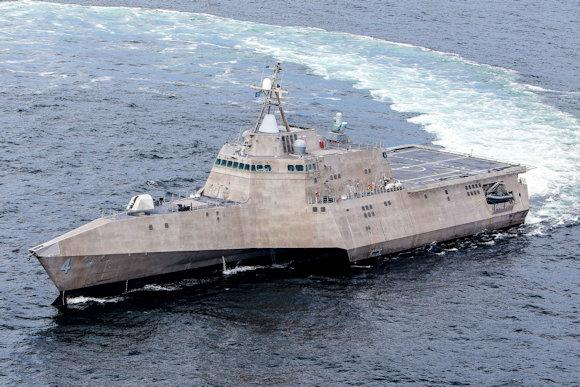There seems to be no peace for the very expensive and controversial program Littoral Combat Ship of the US Navy. The USS Coronado (opening photo and at the bottom), Classe Independenceen route to the Pacific was forced to return to Hawaii due to a powertrain problem. There Coronado, with 70 sailors on board, currently sails at ten knots, approximately 700 nautical miles west of Hawaii, supported by the auxiliary vessel Henry J. Kaiser. The Coronado it left Pearl Harbor last Friday for the Western Pacific, where it would remain in business for at least 16 months based in Singapore.
The extent of the fault is not yet known - reads a statement from the Command of the Third Fleet - we wait for the unit to return to assess the timing of the repairs.
From last December to today, four LCSs have suffered failures of various kinds. The USS Freedom (photo right), leader of the homonymous class, suffered serious damage to the diesel engine. The internal investigation is still ongoing, but the entire main powertrain will need to be replaced. Indiscretions would point the finger at human error. He is currently located in San Diego.
Last December, the brand new Milwaukee, Class Freedom, it literally went out at sea and was towed to port. The cyclical problem was identified in the management software. Naval Sea Systems Command ensures that corrections have been made across the entire class Freedom.
Last January, the USS Fort Worth, on active duty in Singapore, suffered severe damage to its propulsion system. Moored for seven months, it was only ordered on 22 August to return to San Diego for repairs. A note from the Chief of Naval Operations reads “Some accidents were caused by personnel, others by design and design defects. All problems will be solved, while the entire program will be reviewed to identify systemic problems, as well as the retraining and certification of all sailors serving on the LCS ”.
Designed since the 90s and developed following the concept of modularity, the Littoral Combat Ship have tripled their initially estimated cost, reaching the ceiling of $ 550 million per unit (even if there is already talk of $ 700 per boat with the new modifications).
What is believed to be one of the Pentagon's major blunders on the LCS affair was that it burned billions of dollars in contracting out Littoral Combat Ship to two different manufacturers. A dual and totally different construction strategy that bled the Defense budget dry. The two versions produced are so different that separate staff training and assistance programs have been created. A unicum, probably, in the world panorama.
 As if that were not enough, on Littoral Combat Ship structural problems were found. In several reports published by the Pentagon, the real capacity of the Littoral Combat Ship. In three different reports, from 2011 to 2013, critical issues of different nature were found that led to the same conclusion: "the USS Freedom, the first LCS built by Lockheed Martin, would not have survived in a hostile combat environment ”.
As if that were not enough, on Littoral Combat Ship structural problems were found. In several reports published by the Pentagon, the real capacity of the Littoral Combat Ship. In three different reports, from 2011 to 2013, critical issues of different nature were found that led to the same conclusion: "the USS Freedom, the first LCS built by Lockheed Martin, would not have survived in a hostile combat environment ”.
Despite the devices of the Navy, on Littoral Combat Ship problems continued to be encountered with the materials used in the load-bearing structures (they rusted too quickly) and with the excessive vibrations of the main guns which made the aim unstable after the first salvo. Problems also on integrated weapon systems and shortcomings on the performance of the management of hostile contacts.
Finally, the LCS proved too light. An enemy, not in possession of the same technology, could have suffered double damage while still representing a threat.
In 2013, the ship's entire offensive system was branded as highly unstable. The improvements were approved in December 2013, but in a new report in March 2014 it emerged that "the changes would add nothing to the ship's current survivability that was deemed unsatisfactory. The only effective solutions would involve a new design or fundamental change. to the project ".
Despite everything, the program Littoral Combat Ship continues. Future boats will be equipped with internal armor in kevlar, new weapon systems and avionics as well as some measures to reduce the radar signature.
It should be noted that the modular multi-mission packages are still purely theoretical and that between 50 and 60% of the technologies implemented are not considered operational. The development of LCS continues to be plagued by various problems which, in a few years, could also be solved at a much higher price than expected.
The future LCS, designed to be small ships, will in effect be frigates. The project for warships small is to be considered officially closed.
 (photo: US Navy)
(photo: US Navy)












